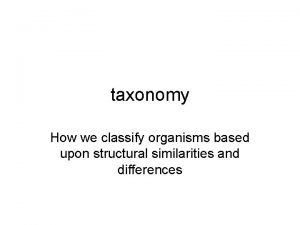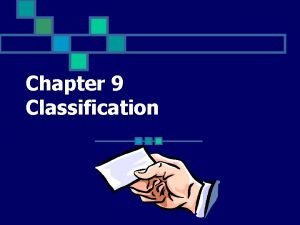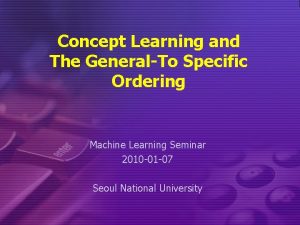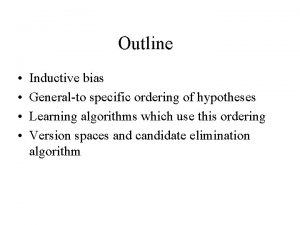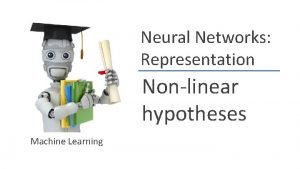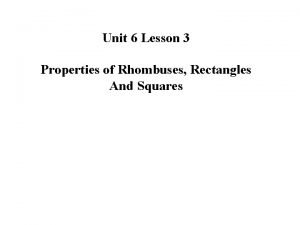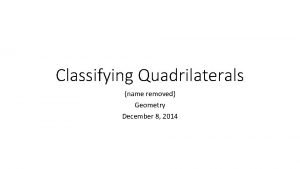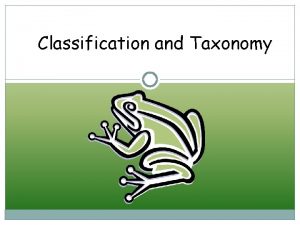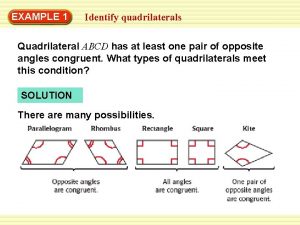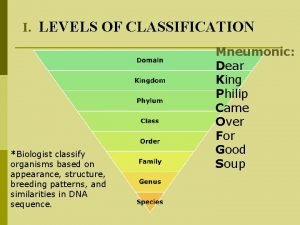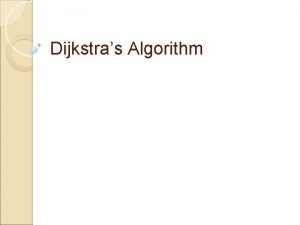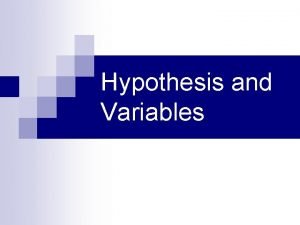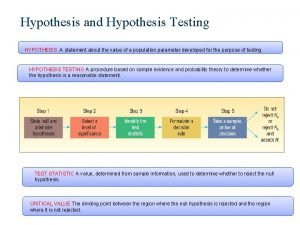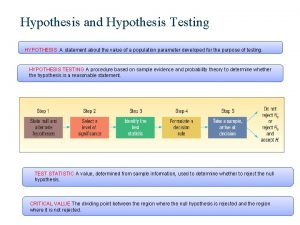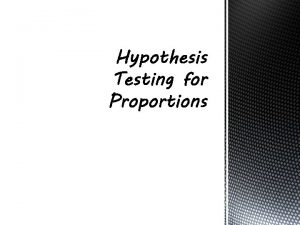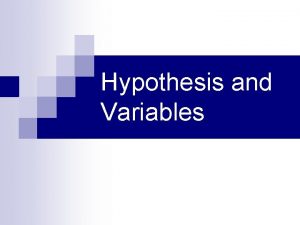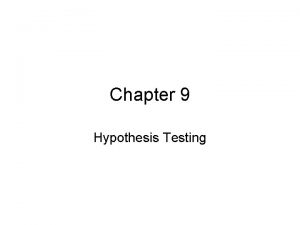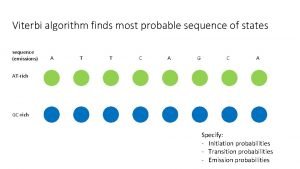FindS Algorithm FINDS finds the most specific hypothesis



















- Slides: 19


Find-S Algorithm • FIND-S finds the most specific hypothesis possible within the version space given a set of training data • Uses the general-to-specific ordering for searching through the hypotheses space

Find-S Algorithm Initialize hypothesis h to the most specific hypothesis in H (the hypothesis space) For each positive training instance x (i. e. output is 1) For each attribute constraint ai in h If the constraint ai is satisfied by x Then do nothing Else Replace ai in h by the next more general constraint that is satisfied by x Output hypothesis h

Find-S Algorithm To illustrate this algorithm, let us assume that the learner is given the sequence of following training examples from the SICK domain: D T BP SK x 1 H H 1 x 2 L L 0 x 3 N H 1 The first step of FIND-S is to initialize hypothesis h to the most specific hypothesis in H: h=<Ø, Ø>

Find-S Algorithm First training example is positive: D x 1 T H BP H SK 1 But h = < Ø , Ø > fails over this first instance Because h(x 1) = 0, since Ø gives us 0 for any attribute value Since h = < Ø , Ø > is so specific that it doesn’t give even one single instance as positive, so we change it to next more general hypothesis that fits this particular first instance x 1 of the training data set D to h=<H, H>


Find-S Algorithm D T BP SK x 1 H H 1 x 2 L L 0 Upon encountering the second example; in this case a negative example, the algorithm makes no change to h. In fact, the FIND-S algorithm simply ignores every negative example So the hypothesis still remains: h = < H , H >

Find-S Algorithm D T BP SK x 1 H H 1 x 2 L L 0 x 3 N H 1 Final Hypothesis: h = < ? , H > What does this hypothesis state? This hypothesis will term all the future patients which have BP = H as SICK for all the different values of T


Candidate-Elimination Algorithm • Although FIND-S does find a consistent hypothesis • In general, however, there may be more hypotheses consistent with D; of which FIND-S only finds one • Candidate-Elimination finds all the hypotheses in the Version Space

Version Space (VS) • Version space is a set of all the hypotheses that are consistent with all the training examples • By consistent we mean h(xi) = c(xi) , for all instances belonging to training set D

Version Space Let us take the following training set D: D T BP SK x 1 H H 1 x 2 L L 0 x 3 N N 0 Another representation of this set D: BP H - - 1 N - 0 - L 0 - - L N H T

Version Space Is there a hypothesis that can generate this D: BP H - - 1 N - 0 - L 0 - - L N H T One of the consistent hypotheses can be h 1 = < H, H > BP H 0 0 1 N 0 0 0 L N H T

Version Space There are other hypotheses consistent with D, such as h 2 = < H, ? > BP H 0 0 1 N 0 0 1 L N H T There’s another hypothesis, h 3 = < ? , H > BP H 1 1 1 N 0 0 0 L N H T

Version Space • Version space is denoted as VS H, D = {h 1, h 2, h 3} • This translates as: Version space is a subset of hypothesis space H, composed of h 1, h 2 and h 3, that is consistent with D • In other words version space is a group of all hypotheses consistent with D, not just one hypothesis we saw in the previous case

Candidate-Elimination Algorithm • Candidate Elimination works with two sets: – Set G (General hypotheses) – Set S (Specific hypotheses) • Starts with: – G 0 = {< ? , ? >} considers negative examples only – S 0 = {< Ø , Ø >} considers positive examples only • Within these two boundaries is the entire Hypothesis space

Candidate-Elimination Algorithm • Intuitively: – As each training example is observed one by one • The S boundary is made more and more general • The G boundary set is made more and more specific • This eliminates from the version space any hypotheses found inconsistent with the new training example – At the end, we are left with VS

Candidate-Elimination Algorithm Initialize G to the set of maximally general hypotheses in H Initialize S to the set of maximally specific hypotheses in H For each training example d, do If d is a positive example Remove from G any hypothesis inconsistent with d For each hypothesis s in S that is inconsistent with d Remove s from S Add to S all minimal generalization h of s, such that h is consistent with d, and some member of G is more general than h Remove from S any hypothesis that is more general than another one in S If d is a negative example Remove from S any hypothesis inconsistent with d For each hypothesis g in G that is inconsistent with d Remove g from G Add to G all minimal specializations h of g, such that h is consistent with d, and some member of S is more specific than h Remove from G any hypothesis that is less general than another one in G

Candidate-Elimination Algorithm D T BP SK x 1 H H 1 x 2 L L 0 x 3 N H 1 G 0 = {< ? , ? >} most general S 0 = {< Ø, Ø >} most specific
 He who finds wife finds a good thing
He who finds wife finds a good thing Most general to most specific classification
Most general to most specific classification Most general to most specific classification
Most general to most specific classification Name of organisms
Name of organisms Most general to most specific classification
Most general to most specific classification Type 1 error vs type 2 error example
Type 1 error vs type 2 error example Alternative hypothesis
Alternative hypothesis Alternativehypothesis
Alternativehypothesis Weakness of protoplanet hypothesis
Weakness of protoplanet hypothesis Find s algorithm machine learning
Find s algorithm machine learning Inductive bias of candidate elimination algorithm
Inductive bias of candidate elimination algorithm Glycerol specific gravity
Glycerol specific gravity Specific gravity and volume
Specific gravity and volume What is this
What is this Which brand of popcorn pops the most kernels hypothesis
Which brand of popcorn pops the most kernels hypothesis The diagonals of rhombus pqrs intersect at t
The diagonals of rhombus pqrs intersect at t Most specific name for quadrilateral
Most specific name for quadrilateral Contributions to classification/taxonomy aristotle linnaeus
Contributions to classification/taxonomy aristotle linnaeus Identify
Identify What are the 8 levels of classification
What are the 8 levels of classification

